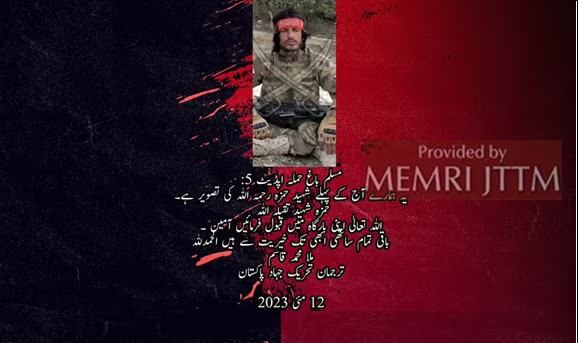
TJP: A Front Group for the Pakistani Taliban?
Publication: Terrorism Monitor Volume: 21 Issue: 17
By:

On July 12, nine Pakistani army soldiers and five militants were killed after security forces retaliated for a “dastardly attack” on Zhob garrison in the northern part of Pakistan’s southwestern province of Balochistan (Dawn, July 12). The Tehreek-e-Jihad Pakistan (TJP), a relatively new militant group, claimed responsibility for the attack (Arab News Pakistan, July 12). This was the seventh attack by the TJP since its formation in February, including three in Khyber Pakhtunkhwa and now four in Balochistan (Arab News Pakistan, June 5). By carrying out high-profile attacks, such as the July 12 attack in Balochistan, the TJP has emerged as the newest militant threat in Pakistan’s security landscape.
TJP’s Formation and Objectives
The TJP was formed to wage jihad against Pakistan with the aim of transforming the country into an Islamic state, imposing a theocratic version of sharia law similar to what the Taliban established in Afghanistan. Abdullah Yaghistani is the head of the group, according to a February announcement by TJP’s spokesman, Mullah Qasim, on social media (Arab News Pakistan, June 5). Yaghistani is believed to have studied at Jamia Farooqia, which is a prominent Deobandi seminary in Karachi; Yaghistani had been involved in fighting US and NATO forces in Afghanistan until the US withdrawal in 2021 (The Khorasan Diary, April 29).
The group outlined its objectives and goals in a February 24 Twitter statement, which claimed that: “We have reached the conclusion that except through armed jihad, the enforcement of an Islamic system is not possible in Pakistan.” It further asserted that, “For the achievement of this objective, for the time being hundreds of mujahideen and dozens of fidayan [martyrdom-seekers] of Islam are ever-ready to sacrifice with money and body … Our targets are the security institutions thrust on Pakistan who are our opponents in this anti-sharia system” (MEMRI, May 18).
According to Mullah Qasim, “after achieving success in Afghanistan, we have extended our struggle into Pakistan” and the group’s struggle is for “the continuation of the Silk Letter Movement.” This refers to a Deobandi movement for independence from British rule that dates back to 1913-1920, when letters requesting support were sent to the Ottoman Empire, Afghanistan, and the German Empire. Nevertheless, Qasim noted that “we have not so far pledged allegiance to anyone, including the Afghan Taliban” (The Khorasan Diary, April 29). The pseudonym “Yaghistani” also refers to the status of Pakistan’s northwestern tribal areas along the Afghanistan border, which had been different before the 1947 partition of the subcontinent and subsequent formation of Pakistan and India. TJP evidently seeks to restore the pre-partition borderlands—which served as a buffer zone between Afghanistan and British India—by attacking Pakistani security forces. The Tehrik-e-Taliban Pakistan (TTP, or “Pakistani Taliban”) also seek to restore the previous status of tribal areas, a demand it highlighted during peace talks with Islamabad last year.
TJP’s High-Profile Attacks
After its formation in February, TJP first claimed the killing of two Pakistani security personnel in Chaman, a border town in Balochistan near the Pakistan-Afghanistan border (Hindu Post, February 26). After the February attack, TJP has claimed the following high-profile attacks (besides the aforementioned July 12 attack on Zhob garrison):
- On March 6, nine paramilitary security personnel were killed and 13 others were injured in Quetta, the capital of Balochistan province, when a suicide bomber drove his motorbike into a security vehicle (Dawn, March 7);
- On April 25, a suicide attack inside Kabal police station in Swat area of Khyber Pakhtunkhwa killed at least a dozen people, including police officials, and injured 57 others (Dawn, April 25);
- On April 27, a motorcycle-borne suicide bomber detonated the bomb near a security forces post in Lakki Marwat district in Khyber Pakhtunkhwa, killing three soldiers (Express Tribune, April 28); and
- On May 12, militants attacked a Frontier Corps (FC, a government-aligned paramilitary force) camp in the Muslim Bagh area of northern Balochistan and killed 14 security personnel (News Vibes of India, May 13).
TJP’s ideology and operations have led some security analysts to believe that TJP is a splinter group of the TTP. However, the TTP has denied any association with TJP. As a result, other analysts believe TJP is indeed a separate and independent group, which may actually be ideologically closer to Islamic State in Khorasan Province (ISKP) (Dawn, July 14).
The majority of analysts nevertheless deem TJP as simply a new brand name for the TTP. They contend that Islamabad places pressure on the Taliban government in Kabul over the TTP’s presence on Afghan soil and its cross-border terrorist attacks against Pakistan. The attacks by the “new” group, TJP, are not claimed by the TTP and, therefore, Pakistan is not able to pressure the said group’s attacks (DND Pakistan, March 9).
Conclusion
TJP has emerged as a new destabilizing factor in Pakistan, particularly in Balochistan, which already suffers from attacks from Baloch ethno-nationalist militant groups, the TTP, and ISKP. Balochistan is also the epicenter of major development activities funded by China under the $62 billion China–Pakistan Economic Corridor (CPEC), which is the flagship project of China’s Belt and Road Initiative (BRI). Both the TTP and TJP hold the same anti-state agenda—with Pakistan’s security forces serving as a shared target. Moreover, both groups want to transform Pakistan into an Islamic state along the lines of the Taliban’s Islamic Emirate of Afghanistan. Regardless of whether or not the TTP and TJP are actually the same group, they are two sides of the same coin.



